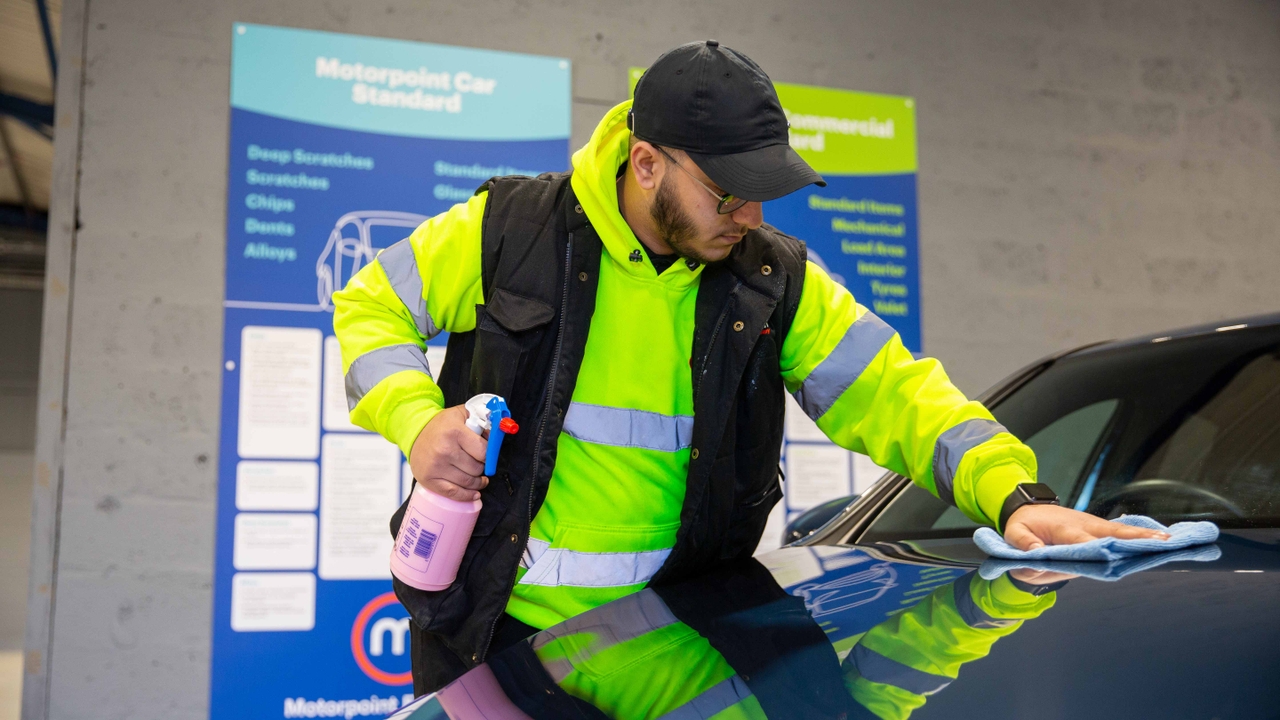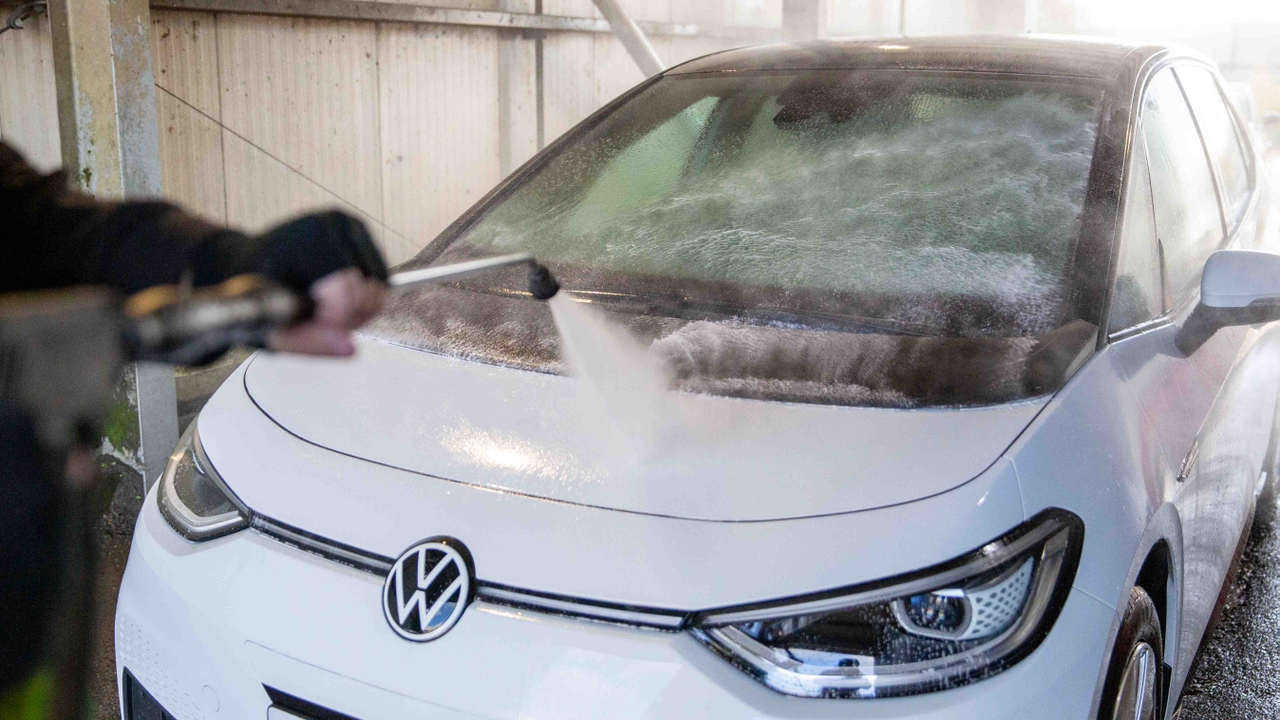There are countless car cleaning products trying to get your attention, and plenty of opinions on the best way to wash a car. It can all seem confusing – and do you even need to wash a car at all? Is it just a massive waste of time?
It can feel like time wasted when your car quickly gets dirty again or a bird takes aim at your paintwork just after you’ve finished, but there are good reasons to wash your car semi-regularly. Not only does it make your car look its best, but car washing products can protect and preserve your paint – which will also help its resale value. You might even find it therapeutic (until you spot a new scratch or stone chip, that is!).
This guide will focus on how to wash a car at home. Automated car washes can be quick and convenient, but heavy brushes can scratch your paint. They often don't do an amazing job of removing dirt from nooks and crannies either, plus they cost money and aren’t suitable for every car. Alternatively, you could go to a hand car wash, but they tend to be more expensive and you may not know exactly what they’re putting on your paintwork.
Car washing tips
- Try to avoid washing your car in direct sunlight – a shaded area is preferable
- Make sure to rinse as much dirt off as possible before you rub anything – such as a wash mitt – over the car
- A sponge can trap dirt and spread it all over your paintwork – consider buying a noodle wash mitt instead
- If you have a pressure washer, using a snow foam pre-rinse will soften dirt so it’s easier to remove
- Use dedicated car shampoo – don’t use washing-up liquid
- Once you’ve done the outside, it’s time to read our guide on how to clean your car interior
Fastest way to wash a car by hand
You only need a few items to give a car a quick wash. These can be bought cheaply from auto parts stores or larger supermarkets – you don’t necessarily need high-end detailing products. You’ll need:
- Wheel and tyre cleaner (if your car shampoo isn’t suitable)
- Car shampoo and a bucket
- Noodle wash mitt
- Hosepipe (or a second bucket with clean water)
- Microfibre drying towel or chamois
This method won’t give a perfectly scratch-free finish or the long-lasting protection you get from waxes and polishes, but it will get the dirt off without you spending hours on the driveway. We’d recommend starting on the wheels and tyres before moving onto the bodywork. A wheel brush or a second wash mitt is a good investment so you don’t drag dirt from the wheels onto the paintwork.
Pour a capful of car shampoo into the bucket and fill up the bucket with water. Start from the top of the car and work downwards with the wash mitt, wiping a panel at a time so you don’t miss any dirt. Clean the wash mitt with water regularly. Once you’ve shampooed the car, wash it off with clean water and dry it with a chamois or an automotive drying towel – not a bath towel. Drying it prevents water spots from appearing and ruining the look.
How to properly wash your car – the nine-step guide

That quick wash routine is fine for just getting the dirt off, but your car will benefit from a more thorough wash whenever you can spare the time. For a proper wash, it’s worth buying a few specialist products, which we’ll cover here.
What is the correct order to wash a car?
1. Pre-clean
The first thing you should do is to spray your hose or pressure washer all over your car, to get some of the surface dirt off. The more dirt you can get off in the pre-rinse phase, the less chance you’re going to scratch your car. Consider using a citrus pre-wash or a traffic film remover to help loosen the dirt, and then rinse off with clean water. You could also use a snow foam if you have a pressure washer, which adds some fun into the process.
2. Tyres and wheels
Your wheels are probably one of the dirtiest bits of the car. They’re in the firing line for road grime and can pick up brake dust. A dedicated wheel cleaner will help to remove dirt and brake dust from your wheels – typically, you spray the product on your wheels and agitate with a soft brush. Leave to dwell for a short time and then rinse off with clean water.
You might find that you’ve missed bits, so a second application of wheel cleaner might be needed – and if possible, move the car forwards just enough to turn the wheels, because then you’ll easily spot if you’ve missed a bit.
3. Shampoo
Car shampoo ranges from entry-level to extravagant, but expensive doesn’t necessarily mean better. Sometimes, you’re just paying for fancy scents and long words, so look for products that are well-rated rather than merely eye-catching. However, some products are worth paying a bit extra for, so it’s worth trying a few products over a few months to see which you like.
Start at the top and cover all paintwork, glass and trim, working on small areas at a time with a wash mitt. We don’t recommend using a traditional sponge, because this can spread dirt around and scratch your car's clearcoat. Have one bucket full of shampoo and water and another bucket with clean water in, so you can regularly wash your mitt to remove any dirt. Make sure the shampoo doesn’t dry onto the car, as this will leave unpleasant-looking streaks and may be difficult to remove.
4. Decontamination
It might not be immediately obvious, but your car can pick up contaminants such as iron dust, tree sap and tar, and these usually are too hard to shift for normal car shampoos. Every now and again, add a decontamination stage to your wash. Fallout remover can be sprayed onto the car to remove iron particles – many turn bright colours to show you that they’re picking up contaminants – while tar and glue remover is good for stubborn black spots that might show up near the wheel arches. Clay bars and lubricants are other options that leave your paintwork incredibly smooth to the touch. Once you’ve done the decontamination stage, wash off the products you’ve used.
5. Drying
A high-quality drying towel or chamois leather can make the drying process a lot easier and quicker. You could also use a water blade to squeegee the water off – but this could pick up dirt when you’re not using it – or you could push the boat out and use a hot air blower for a non-touch drying method. With a drying towel, work panel by panel and pull the towel across the panel to get all the water off.
6. Glass
Don’t forget your windows – smeary marks, fingerprints and water spots will ruin the freshly washed look. Glass cleaner is a must for your car cleaning kit, as it’ll leave your windows clean and clear. You don’t even need to buy anything expensive – some glass cleaners from high-street stores do the job perfectly well.
7. Polish

Polish should be applied every few months to make your paint look its best and to add extra protection. Most polishes need to be applied to a dry car with a clean cloth or polish applicator and then wiped off with a second clean cloth (or an old plain t-shirt). You could also use a machine polisher for an even better finish, but make sure you get a scrap body panel to practice on first – as using it wrong can burn through your paintwork which will mean an expensive respray.
8. Wax
Car waxes protect the paint and help to keep the polish in place. They also make it harder for dirt to stick, so you might find it easier to keep your car clean if it's been waxed. Car wax is available in pots or sprays. Wax can be quite expensive but a little goes a long way.
9. Finishing touches
Now’s the time to take a close look at your car to see if you’ve missed anything. Metal polish will keep chrome trim and exhaust pipes looking fresh, and tyre shine or tyre gel will give you that showroom finish for your tyres. A rapid detailing spray will remove any watermarks or fine dust, and a back-to-black trim restorer will give new life to any faded plastic trim. Wipe the dirt off the inside of the doors, as well.
How to wash a car without a hose
If you don’t have access to an outside tap or can’t stretch your hose far enough, there are ways to keep your car looking shiny. Simply use two buckets when you wash your car – one with shampoo in, and one with just clean water, so you can rinse off the shampoo once you’ve finished washing the bodywork. Use a different wash mitt in each bucket.
Alternatively, you could take all your car cleaning supplies to a local jet wash and use their water, but the two-bucket method is probably going to be far more convenient.
How to wash a car with a pressure washer

Washing a car with a pressure washer can be a fast and effective way of getting the dirt off. First, connect your pressure washer to an electricity supply and a water supply. If your pressure washer has different modes and settings, make sure it’s set to the right one – some pressure washers have a setting that’s alright for patios but too hard for cars.
Start by going over the car just with water. Then attach your pre-rinse product, such as snow foam, and thoroughly cover the car. Unlike washing by hand, you should start low down on your car and work upwards. Leave the product to dwell on the car for a few minutes and then rinse off with clean water.
Next, apply your shampoo – many car care companies sell pressure washer-specific shampoos – and, again, thoroughly cover the car. You will still need to wash the car by hand with a wash mitt at this stage, to make sure that stubborn dirt is removed. Then, wash off the shampoo with the pressure washer before the shampoo dries on. Dry the car as above.
How often should you wash your car?
In an ideal world, you should wash your car once every two weeks. That’s not always feasible, so our advice would be to wash it as often as you can. Try to wash off bird droppings as soon as possible, or else you risk permanently damaging the paint.
In winter, it seems futile to wash your car when the roads are so salty and grimy, but it’s important to wash off that road salt as it can cause corrosion if left too long. And remember that your numberplates and lights always need to be visible.
In summer, you should also aim to wash your car every couple of weeks. Flies that hit your car’s front end can become hard to remove if left for long periods, and a smeary windscreen will make visibility difficult in sunny weather.
How often should you wax your car?
Typically, you should wax your car every three months or so, but make sure to check what it says on the product that you buy. Some claim to offer six months’ protection or more, so these may not need to be applied quite as regularly.
How to clean your tyres
Spray the cleaning product you’re using – be it a wheel cleaner or degreaser – liberally over the sidewalls of your tyres and leave to dwell for a minute or two. Don’t spray anything over the treads of your tyres – this can affect handling and braking performance. Scrub the tyre sidewalls with a relatively firm brush and you should see some dirt coming off. Wash it off with clean water and repeat the process if needed.
Can you use washing-up liquid to clean a car?
No, no, no, please keep the Fairy in the kitchen! Washing up liquid is too abrasive for your car’s paint – it’ll strip off waxes and polishes, and can damage paintwork if used regularly. It can also dull a car’s shine. Even the cheapest car shampoo, which you can buy for several pounds, is much better suited to your car than a bottle of washing-up liquid. After all, you wouldn’t use an upholstery cleaner on your plates, would you?
How to wash a car with matt paint
Matt paint is becoming far more common – it’s becoming a fashionable finish for sporty and luxury cars. Buyers seem to love the way it looks, but it needs more care and attention than traditional gloss or metallic paint.
It’s best to hand-wash matt paint, with a special matt cleaner that’s pH-neutral. Make sure to rinse the car with clean water regularly throughout the washing process, and don’t use any polishes or waxes as these can ruin the finish. Bird droppings must be wiped off as soon as you notice them.
Keep your car looking its best
All our used cars meet our meticulous Motorpoint Quality Standard and feel factory-fresh. Why not keep that new-car feel with Williams Paint Protection?
If you're not sure what car to buy, take a look at our guides to the best small cars and best electric family cars for inspiration.

































